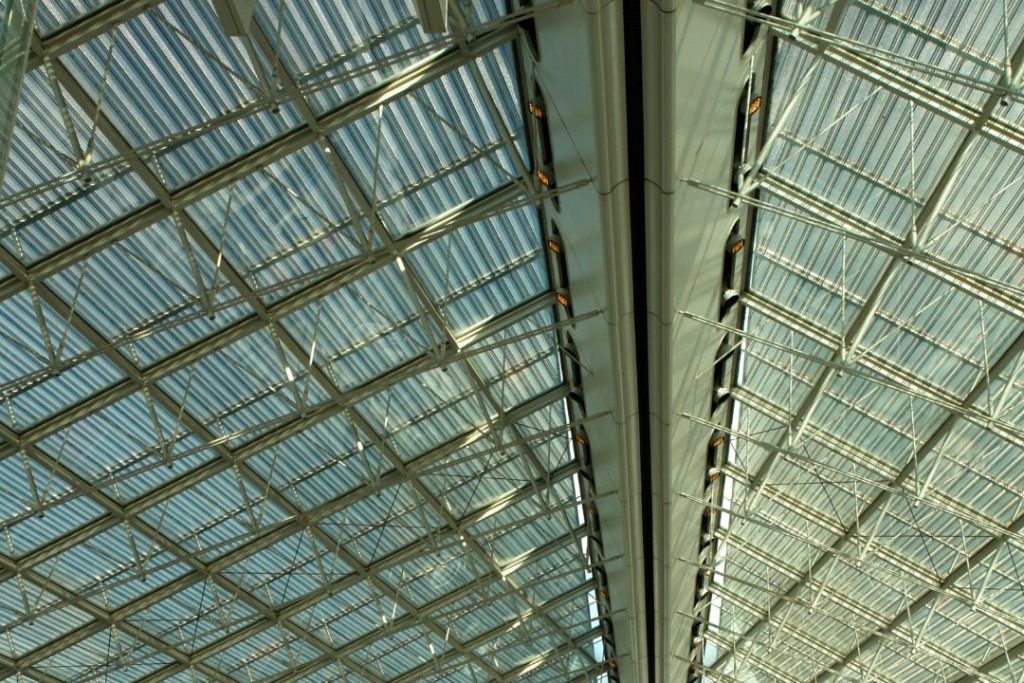Vaulted Ceilings of your home are an essential aspect that plays a critical role in the overall design and feel of your living area. One common ceiling design that can dramatically increase the aesthetic appeal of your home is the vaulted ceiling. This type of ceiling is characterized by its high and sloping curve. Bringing an exquisite touch to any room. In this post, we will discuss all you need to know about vaulted ceilings, including their benefits, diverse types, materials, and installation methods.
What are Vaulted Ceilings?
A vaulted ceiling is a style of ceiling design where the ceiling height is greater than the typical height of a space, producing a sloping look. This form of the ceiling can be encountered in numerous architectural styles, such as Gothic, Tudor, and Georgian. Vaulted ceilings are normally taller than nine feet and can reach up to 20 feet or more. The style of a vaulted ceiling makes a space appear more large and majestic, which is why it is a favorite choice for many homeowners.
Advantages of Vaulted Ceilings
Vaulted ceilings offer various benefits to homeowners, including:
- Increasing Natural Light
Vaulted ceilings allow more natural light to enter a room, providing a bright and spacious feel. This is because the high ceiling allows light to enter from multiple angles, making the room feel more open.
- Spaciousness
Vaulted ceilings make a room feel more expansive, even though the actual floor space remains the same. The high ceiling pushes the eye upward, producing an appearance of more height and space.
- Aesthetic Appeal
Vaulted ceilings are a beautiful addition to any home. They provide a touch of richness and grandeur to any area, making it feel more sophisticated.
Styles of Vaulted Ceilings
There are numerous styles of vaulted ceilings that you may choose from to fit your particular preferences and the architecture of your home.
- Cathedral Ceiling

A cathedral ceiling is a sort of vaulted ceiling where the ceiling height follows the pitch of the roof. This produces a triangular shape, with the tallest point in the center of the ceiling. In churches and other religious structures, this design is common.
- Shed Ceiling

A particular style of vaulted ceiling known as a shed ceiling follows the slope of a single roof. Its design makes a smooth transition from the roof to the ceiling, making it perfect for homes with sloping roofs.

- Barrel Ceiling

A vaulted ceiling style known as a “barrel ceiling” produces an arching, curving shape. Grand entryways, dining rooms, and other formal portions of a home frequently have this design.
- Groin Vault Ceiling

A vaulted ceiling style known as a groin vault is made up of two barrel vaults that cross at an angle. Hallways, foyers, and grand entrances frequently include this design.
Materials for Vaulted Ceilings

Depending on your budget and personal preferences, you may build a vaulted ceiling using a variety of materials.
- Wood
Wood gives warmth and dimension to a space, making it a popular choice for vaulted ceilings. To create a rustic or modern appearance, use different types of wood like cedar, pine, or oak.
- Plaster
In traditional or historic homes, plaster is a timeless material for vaulted ceilings. Plaster is a flexible material and perfect for unique designs because it can be moulded into a variety of forms and patterns.
- Metal
Modern materials like metal can give a space an industrial or contemporary feel. Metals of all kinds, including copper, tin, and aluminium, can be used to produce a sleek, contemporary look.
- Tiles
When it comes to vaulted ceilings, tiles are a tough and adaptable material, especially in bathrooms or kitchens. To create a distinctive appearance you can select from a variety of tile kinds such as ceramic or glass.
Installation Process of Vaulted Ceilings
A competent contractor should complete the complicated installation of a vaulted ceiling. The main installation method steps are as follows:
- Planning and Design
Planning and designing the vaulted ceiling with your contractor is the first stage. Choosing the type of vaulted ceiling, the materials, and the design components like lighting and moulding are necessary for this.
- Structural Changes
To fit the vaulted ceiling, it could be required to make structural adjustments to the current ceiling. This can entail demolishing walls, putting up support beams, or strengthening the current structure.
- Installation of Framework
The support beams and ceiling framing are subsequently added, creating the vaulted ceiling’s framework.
- Installation of Materials
This is vaulted ceiling’s chosen components—whether they are made of wood, plaster, metal, or tiles—are next installed.
- Finishing Touches
The finishing touches, including trim, moulding, and lighting fixtures, are added as the last step.
Maintaining Vaulted Ceilings
A vaulted ceiling is simple to maintain and requires little maintenance. Here are some pointers for maintaining the condition of your vaulted ceiling:
- Regular Cleaning
To avoid filth and dust accumulation, regularly dust and clean your vaulted ceiling. To prevent scratching the surface, use a soft cloth or a vacuum cleaner with a soft brush attachment.
- Eliminate Water Damage
Avoid water damage if your vaulted ceiling is made of plaster or tile by addressing any leaks right away. The material of the ceiling may become warped and discoloured as a result of water damage.
- Fix any damage or cracks
Immediately have your vaulted ceiling fixed by a qualified contractor if you discover any cracks or damage.
The Pros and Cons of Vaulted Ceilings
Vaulted ceilings are becoming more and more common in modern homes because of how unique they look and how stylish they feel. They can give a room a feeling of grandeur and space, but there are some drawbacks to take into account. In this post, we will talk about its pros and cons to help you decide if they are the best choice for your home.
Vaulted ceilings are taller than usual, usually between 11 and 15 feet. They give a space a feeling of openness and airiness, making it appear larger and more welcoming. They can be found in both traditional and modern home designs.
The Pros of Vaulted Ceilings
Sense of Spaciousness
Vaulted ceilings give a room a feeling of openness and space, making it appear larger than it is. This is especially useful in homes with low ceilings or smaller spaces.
Aesthetic Appeal
Vaulted ceilings provide a distinctive and fashionable appearance that can increase your home’s value. They can also produce a large and dramatic effect that many homeowners could find appealing.
Improved Air Circulation
Higher ceilings result in a more comfortable living environment because there is more space for air to flow. Enhancing airflow can also assist in lowering energy expenditures.
Increased Natural Light
A room can become brighter and more inviting by having vaulted ceilings, which can let in more natural light. Also, this can lessen the demand for artificial lighting and lower energy expenses.
The Cons of Vaulted Ceilings
Difficulty with Temperature Control
One of the main problems with vaulted ceilings is that they can be hard to heat and cool well. Higher ceilings can make it harder to keep a room warm and make the heat escape more quickly. As a result, energy bills may increase and living conditions may become less comfortable.
Difficult to Clean and Maintain
It can be hard to keep and clean vaulted ceilings, especially if they are in places that are hard to get to. This could make it hard to keep them looking their best, which can be stressful for the people who own them.
Acoustics
Vaulted ceilings can make it difficult to hear conversations, enjoy music, or watch movies because they can cause a lot of echo and reverberation in the space. This might be a particular issue in rooms with an open layout or larger ones.
Cost
Installing vaulted ceilings can be expensive, especially if a professional is required. Some homeowners might decide that this is not worth the expense because it might be a substantial investment.
Conclusion
These ceilings can add beauty and style to your house, but they also have advantages and disadvantages that you should carefully weigh. While they can increase airflow, natural light, and a sense of spaciousness, they can also be challenging to maintain and regulate temperature. Installing a vaulted ceiling should ultimately depend on your particular choices and lifestyle requirements.
FAQs
Do vaulted ceilings cost more than flat ceilings?
Absolutely, due to the additional materials and labour needed for installation, vaulted ceilings can be more expensive than regular ceilings.
Which room in my house may I construct a vaulted ceiling in?
Depending on the height and design of the area, you can construct a vaulted ceiling in any room of your house.
Can I put it in my own vaulted ceiling?
Installing a vaulted ceiling oneself is not advised because it can be a difficult and hazardous task. The best course of action is to work with a qualified builder with vaulted ceiling installation experience.
Which lighting is most suitable for a vaulted ceiling?
Since it produces a soft and uniform distribution of light, recessed lighting is a popular option for vaulted ceilings.
Is it possible to insulate a vaulted ceiling?
Certainly, vaulted ceiling insulation can aid with temperature control and energy efficiency. The best course of action is to seek advice from a qualified contractor on the kind and quantity of insulation that should be used.
Can I build a vaulted ceiling out of any material?
While there are many materials that may be used to create a vaulted ceiling, it’s necessary to take into account the weight and structural soundness of the current ceiling. To choose the ideal materials for your particular scenario, it is best to speak with a qualified contractor.
What is the duration of a vaulted ceiling installation?
Depending on the size, complexity, materials, and architectural components of the space, the installation method for a vaulted ceiling may change. For the most accurate estimate of the projected timetable for your particular job, it is preferable to speak with a qualified contractor.
How can I keep my vaulted ceiling looking beautiful?
Your vaulted ceiling’s aesthetic charm can be preserved with regular cleaning and upkeep. Your ceiling’s appearance can also be improved by upgrading the lighting fixtures or adding decorative accents like crown moulding.
Can a vaulted ceiling be installed in a small space?
Indeed, you can add a vaulted ceiling to a compact space to give it a sense of height and space. To choose the right size and style for your particular space, you need to take into account the room’s overall proportions and consult a qualified constructor.
Do modern homes still have vaulted ceilings?
Certainly, vaulted ceilings are still a common design element in contemporary homes, especially in rooms with high ceilings and open-concept living spaces. In addition to adding a feeling of drama and grandeur to any space, they can also offer useful advantages like better ventilation and natural illumination
Are vaulted ceilings more expensive to maintain?
Since vaulted ceilings can be hard to clean and often need special techniques or tools, they can be more expensive to keep up.
Can vaulted ceilings increase home value?
Vaulted ceilings are a desirable feature that many purchasers find appealing, so they can increase a home’s value.
Are vaulted ceilings energy-efficient?
Because they are harder to heat and cool effectively, vaulted ceilings may use more energy than regular ceilings.
Can vaulted ceilings be added to an existing home?
You can add vaulted ceilings to an existing house, but it may be a big restoration job that needs professional installation.
How do I know if a vaulted ceiling is right for my home?
When deciding if a vaulted ceiling is an appropriate choice for your home, take into account the size of your house, your lifestyle requirements, and your budget. If you’re unsure, get expert advice.




